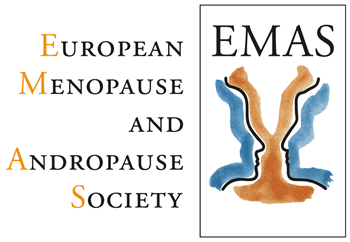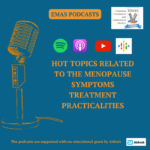Host: Welcome to today’s podcast. Timing Hypothesis and the Window of Opportunity. This episode is part of a podcast series supported by Abbot. The content is solely the responsibility of EMAS, the European Menopause and Andropause Society. All our episodes are available in English, Spanish, Mandarin, and Russian, and you can find them on any of the most popular podcast platforms.
On today’s episode, Gesthimani Mintziori, an endocrinologist, and reader in the Aristotle, University of Thessaloniki School of Medicine, Greece, will help us understand what the timing hypothesis is and why it is considered as a window of opportunity.
Prof. Gesthimani Mintziori: Hello. Actually, I would like to thank EMAS, the European Menopause and Andropause Society for this opportunity, and I hope that it will help to raise awareness of this very important topic. Women’s health is now a global health priority, and menopausal hormone therapy is often used. We need to have in mind that the effects of menopausal hormone therapy vary depending on hormone therapy itself, and I mean the type of hormone therapy, the dose, and the root of administration. But also on patients’ parameters like age, comorbidity status, and of course, last but not least, time since menopause. Time since menopause is indeed an important factor. And it’s actually the basis of the timing hypothesis. But let’s start by clarifying some things about that. The Timing Hypothesis was first introduced to the scientific community in the nineties by Clarkson and colleagues. With their early studies involving non-human primates. They saw that hormone replacement therapy leads to a reduction of coronary artery atherosclerosis by 50 to 70% when it is administered at the time of an oophorectomy. Whereas no benefit is shown when the hormonal administration is performed 2 years after oophorectomy or if we talk in human years that’s the equivalent to 6 years.
It seems that the progression of atherosclerosis can be stopped only before atherosclerotic plaques are formed. And we also have some experiments that tested the cognitive fraction and they saw that early, but not late administration of hormone replacement therapy led to beneficial outcomes.
Interviewer: Okay. Are there any studies to test this hypothesis in humans?
Prof. Mintziori: Yes, indeed. We have a number of observational studies. We have a few (unintelligible) that have been performed to test the hypothesis. And we also have data from secondary analysis from large (unintelligible) studies like the WHI study, the women health initiative study. To remind you, the WHI was prematurely stopped because of increased adverse cardiovascular events in women taking hormone replacement therapy. However, a secondary analysis by age group found out that women treated belonging to the age group of 50 to 59 years old had no increased cardiovascular risk. And the analysis, the secondary analysis also saw that the younger postmenopausal women had a significantly reduced risk of myocardial infarction and CHD.
Interviewer: Okay. So what do you think is the main clinical message regarding the timing hypothesis?
Prof. Mintziori: Well, based on the evidence we have from original studies. We even have some meta-analysis now on the topic. I would say that for women without any risk of venous thromboembolism, cardiovascular disease, or breast cancer, who are under 60 years of age, and who are within 10 years of their last menstrual cycle, hormone therapy is a safe option to control their symptoms. And it will also lead to other beneficial outcomes, including reductions in the risk of fracture and type 2 diabetes in these women. For women with primary ovarian failure or premature menopause, the initiation of hormone replacement therapy is suggested not only to treat their symptoms, the vasomotor or genitourinary symptoms, but also to prevent the long-term health adverse outcomes these women might have. Like CVD and osteoporosis.
Host: Today, Professor Gesthimani Mintziori discussed the timing hypothesis and why he is considered a window of opportunity. Thank you for listening to today’s episode. We hope it will be valuable for your clinical and research practice. Stay safe.
[END]


